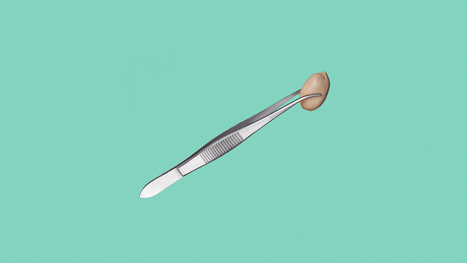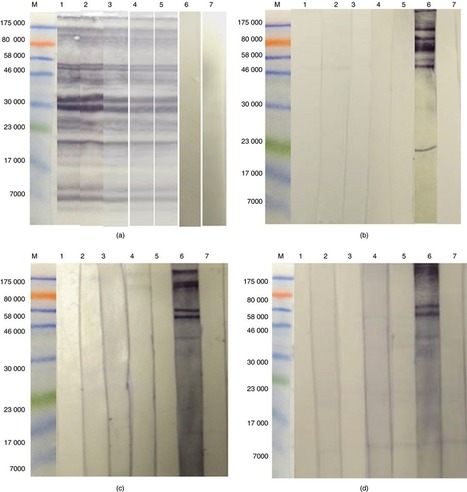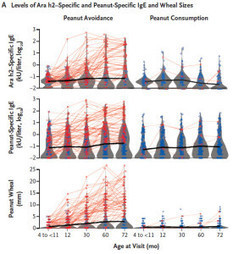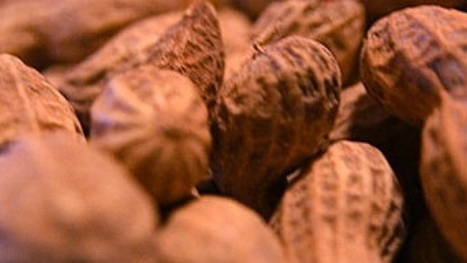 Your new post is loading...
 Your new post is loading...

|
Suggested by
Société Francaise d'Immunologie
August 22, 2017 4:54 AM
|
PPOIT provides long-lasting clinical benefit and persistent suppression of the allergic
immune response to peanut.

|
Scooped by
Gilbert C FAURE
June 5, 2017 10:31 AM
|
Amid the rise in food allergies, two new treatments are on the verge of approval. David Crow on how they work and why our food has turned against us

|
Suggested by
LIGHTING
February 16, 2017 2:53 PM
|
The antigenic reactivity of constituents of Schistosoma mansoni and peanut (Arachis hypogaea) was investigated to determine whether identical antigenic epitopes possessed by both organisms provided

|
Scooped by
Gilbert C FAURE
January 6, 2017 10:12 AM
|
In light of recent allergen-exposure studies, an agency-sponsored panel has formally recommended early introduction of peanuts in an effort to prevent potentially life-threatening allergies.

|
Suggested by
Société Francaise d'Immunologie
November 16, 2016 4:26 AM
|
This review discusses past and current guidelines concerning the timing of the introduction of peanut to reduce infants’ risk of developing peanut allergies.

|
Scooped by
Gilbert C FAURE
October 27, 2016 5:00 AM
|
The prevalence, natural history and time trends of peanut allergy over the first 10 years of life in two cohorts... https://t.co/KPw0gZ0Nkn

|
Scooped by
Gilbert C FAURE
August 2, 2016 4:30 AM
|

|
Suggested by
Société Francaise d'Immunologie
June 20, 2016 12:36 PM
|
The discovery could lead to genetically-engineered peanuts without the allergens.

|
Scooped by
Gilbert C FAURE
May 31, 2016 1:59 PM
|
Simultaneous pre-treatment with antihistamines that block both the H1 and H4 antihistamine receptors suppressed the gastrointestinal symptoms of food allergy in mice, according to researchers at National Jewish Health.

|
Scooped by
Gilbert C FAURE
March 8, 2016 4:44 AM
|
Over the past few decades, allergies have been on the rise worldwide, particularly in the United States.

|
Scooped by
Gilbert C FAURE
March 6, 2016 5:57 AM
|
New England Journal of Medicine Peanut Study Makes Debut at AAAAI Annual Meeting

|
Scooped by
Gilbert C FAURE
February 23, 2016 9:55 AM
|

|
Scooped by
Gilbert C FAURE
February 15, 2016 9:06 AM
|
Peanut allergy is one of the most common food allergies, and can cause severe, potentially fatal, allergic reactions, including anaphylaxis.
|

|
Scooped by
Gilbert C FAURE
July 25, 2017 9:01 AM
|
Many vital specialties, including paediatrics, emergency medicine and mental health, are struggling with severe staff shortages. In fact, the NHS shortfall could run to thousands of doctors.
Allergic disorders have now become a major worldwide public health issue, but the effective treatment options remain limited. We report a novel approach to block allergic reactivity by targeting the surface-bound IgE of the allergic effector cells via low-affinity anti-human IgE Abs with dissociation constants in the 10−6 to 10−8 M range. We demonstrated that these low-affinity anti-IgE mAbs bind to the cell surface–bound IgE without triggering anaphylactic degranulation even at high concentration, albeit they would weakly upregulate CD203c expression on basophils. This is in contrast to the high-affinity anti-IgE mAbs that trigger anaphylactic degranulation at low concentration. Instead, the low-affinity anti-IgE mAbs profoundly block human peanut- and cat-allergic IgE-mediated basophil CD63 induction indicative of anaphylactic degranulation; suppress peanut-, cat-, and dansyl-specific IgE-mediated passive cutaneous anaphylaxis; and attenuate dansyl IgE-mediated systemic anaphylaxis in human FcεRIα transgenic mouse model. Mechanistic studies reveal that the ability of allergic reaction blockade by the low-affinity anti-IgE mAbs was correlated with their capacity to downregulate the surface IgE and FcεRI level on human basophils and the human FcεRIα transgenic mouse bone marrow–derived mast cells via driving internalization of the IgE/FcεRI complex. Our studies demonstrate that targeting surface-bound IgE with low-affinity anti-IgE Abs is capable of suppressing allergic reactivity while displaying an excellent safety profile, indicating that use of low-affinity anti-IgE mAbs holds promise as a novel therapeutic approach for IgE-mediated allergic diseases.
Via Krishan Maggon

|
Scooped by
Gilbert C FAURE
January 30, 2017 12:09 PM
|
Background: The prevalence of food allergy has been increasing, but treatment is very limited. DNA vaccination has been recognized as a promising method for the treatment of allergic diseases; however, poor immunogenicity has hindered its application. Methods: BALB/c mice were intradermally injected with plasmid DNA encoding the peanut protein Ara h 2 (pAra h 2) or pAra h 2 pretreated with poly-L- lysine (PLL) before or after sensitization with Ara h 2 protein. Ara h 2-specific antibodies were measured by ELISA. CD207+ dendritic cells (DCs) and Treg cells in draining lymph nodes were analyzed by flow cytometry after DNA immunization, and cytokine production in splenocytes was also analyzed. Results: In the prophylactic study, pretreatment with pAra h 2 or PLL-pAra h 2 resulted in lower levels of Ara h 2-specific IgG1, IgG2a, and IgE after sensitization with Ara h 2 protein, and mice in the PLL-pAra h 2 group had a significantly lower level of antibodies than those in the pAra h 2 group. In the treatment study, intradermal injection with pAra h 2 or PLL-pAra h 2 after Ara h 2 protein sensitization significantly decreased the level of Ara h 2-specific antibodies, and PLL- pAra h 2 had stronger effects than pAra h 2. There were increased numbers of CD207+ DCs and Treg cells in the mice receiving intradermal injection with PLL-pAra h 2, and splenocytes from PLL-pAra h 2-treated mice secreted increased levels of IFN-#x03B3; and IL-10. Conclusions: Modification of pAra h 2 with PLL improved its prophylactic and therapeutic effects in peanut-allergic mice.
Int Arch Allergy Immunol 2016;171:241-250

|
Scooped by
Gilbert C FAURE
January 6, 2017 8:58 AM
|
Food allergy is an important public health problem because it affects children and adults, can be severe and even life-threatening, and may be increasing in prevalence. Beginning in 2008, the National Institute of Allergy and Infectious Diseases, working with other organizations and advocacy groups, led the development of the first clinical guidelines for the diagnosis and management of food allergy. A recent landmark clinical trial and other emerging data suggest that peanut allergy can be prevented through introduction of peanut-containing foods beginning in infancy. Prompted by these findings, along with 25 professional organizations, federal agencies, and patient advocacy groups, the National Institute of Allergy and Infectious Diseases facilitated development of addendum guidelines to specifically address the prevention of peanut allergy. The addendum provides 3 separate guidelines for infants at various risk levels for the development of peanut allergy and is intended for use by a wide variety of health care providers. Topics addressed include the definition of risk categories, appropriate use of testing (specific IgE measurement, skin prick tests, and oral food challenges), and the timing and approaches for introduction of peanut-containing foods in the health care provider’s office or at home. The addendum guidelines provide the background, rationale, and strength of evidence for each recommendation. Guidelines have been developed for early introduction of peanut-containing foods into the diets of infants at various risk levels for peanut allergy.

|
Scooped by
Gilbert C FAURE
October 27, 2016 9:36 AM
|
After a year of clinical trials - which are ongoing - researchers at the National Institutes of Health say the results are astonishingly positive, particularly in children under 12 years old.

|
Scooped by
Gilbert C FAURE
September 21, 2016 7:25 AM
|
New research published today shows the early introduction of egg (from four to six months) and peanuts (from four to 11 months) is linked to lower rates of egg and peanut allergy.

|
Scooped by
Gilbert C FAURE
July 24, 2016 3:52 AM
|
Despite fears the mere presence of a peanut on a plane could inflame allergies, a Transportation Ministry inquiry has found "limited risk" anything other than actually ingesting a nut will cause an anaphylactic reaction.

|
Scooped by
Gilbert C FAURE
June 10, 2016 9:02 AM
|
Background: Peanut allergy is one of the most severe food allergies in children. The diagnostic gold standard is the oral food challenge (OFC). However, OFC has inherent risks and is time consuming.

|
Suggested by
Denise Neves Gameiro
May 13, 2016 1:26 PM
|
The European Biotech News Website

|
Scooped by
Gilbert C FAURE
March 6, 2016 5:58 AM
|
Original Article from The New England Journal of Medicine — Effect of Avoidance on Peanut Allergy after Early Peanut Consumption

|
Scooped by
Gilbert C FAURE
March 6, 2016 5:57 AM
|
The long-lasting effects of eating peanut products as a baby to avoid the risk of allergy are supported by new research.

|
Scooped by
Gilbert C FAURE
February 17, 2016 9:02 AM
|
Int Arch Allergy Immunol 2015;168:147-149
|




 Your new post is loading...
Your new post is loading...

























